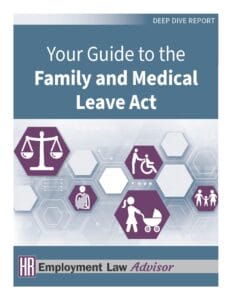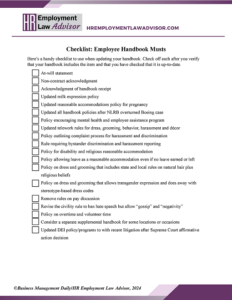Legal analysis for busy HR professionals
HR Employment Law Advisor is a comprehensive service offering legal analysis and practical advice on how to navigate the employment law landscape
Here come the new state employment laws for 2025
States are emerging as prime sources of new employment-related laws. Congress didn’t pass much in the way of employment laws at the federal level this year. The Supreme Court largely steered clear of issuing opinions on employment-law questions (although one case did address sex discrimination).
That has left states to pick up the slack, subjecting employers to a dizzying array of new labor and employment laws. Here is a sampling of new laws scheduled to go into effect on Jan. 1, 2025, or soon after.
Background checks
Arizona’s home health-care agency law has been amended to require employers hiring home health-care workers to conduct background checks. Before hiring, employers must contact all previous employers to ask about the applicant’s fitness to work with patients and clients. Each applicant must also be checked against the adult protective services registry.
Oregon also passed a law requiring background checks for workers providing direct care to clients and patients.
New Hampshire prohibits registered sex offenders from working at businesses that provide services to minors or jobs that require supervision of minors.
Child labor
Several states have tightened their child-labor laws. Others loosened them.
California employers that perform voluntary child-labor audits to confirm they don’t violate child-labor laws must post the audit on their websites.
Colorado increased the penalties for violating child-labor rules.
Illinois completely revamped its child-labor laws to provide greater protection.
Indiana loosened its laws, expanding work hours and completely removing hour and time restrictions for minors aged 16 and older.
CROWN Act
California has amended its discrimination law to include discrimination based on hair texture and protected hairstyles.
Domestic violence leave
California employees can take leave when an employee or family member is a victim of an act of violence. Employers must also provide reasonable accommodations to prevent further violence, effectively making the workplace a safe zone. California also made it easier for employers to obtain a restraining order on behalf of employees who have been harassed.
Paid sick leave
Connecticut expanded paid sick leave to all employers with 25 or more workers and prohibits employers from requiring employees to document the need for that leave.
New York requires employers to provide up to 20 hours of paid leave for pregnancy needs.
Pay transparency
Several states require starting salaries to be posted with job ads.
Illinois requires employers with 15 or more workers to post the pay scale and all benefits in all ads.
Minnesota employers with 30 or more workers must include a full salary range in ads, along with a summary of benefits.
Workplace safety
California requires Cal/OSHA, the state’s occupational safety and health agency, to pass regulations requiring employers to include Narcan in first-aid kits to reverse narcotic overdoses. Another California law requires Cal/OSHA to pass regulations to require hospitals to screen for weapons.
Final note: This list does not cover every new law. Check with your state department of labor for the latest minimum-wage increases and any other new laws or regulations effective in 2025.
Use objective reasons to justify terminations
There are lots of legitimate reasons employers might need to terminate employees. A new hire might not be performing up to expectations. Perhaps a supervisor doesn’t believe a subordinate is contributing enough to team efforts. Maybe senior leaders want to save money by eliminating jobs.
In all cases, HR must review the reason for the termination and ensure the decision will be defensible in court should the former employee decide to file a lawsuit.
It is almost always best to focus on objective reasons rather than resorting to subjective assessments. Ensure that all terminations are based on solid business reasons. And be sure to carefully document why you decided to terminate, even if you don’t share the rationale with the employee.
Recent case: The EEOC has settled a case involving the termination of the only Black project manager working for Sureste Development. At first, the real estate company said the manager performed well. However, he was terminated less than a year after he began working at Sureste. The stated reason was that he was “lazy” and not a good fit for the company’s “culture.”
He filed a complaint with the EEOC claiming he had been assigned more work than the company’s other project managers who were not Black. The EEOC sued on his behalf.
Then Sureste changed its story, explaining it had terminated the man because it had eliminated his position. But during discovery, it turned out that Sureste’s records showed it had promoted a significantly less-qualified white employee to the same position the Black project manager held.
Instead of taking its chances in court, Sureste agreed to settle the case. The fired project manager will receive $70,000, and the company must train all its supervisors, managers and employees on discrimination.
Note: Shifting reasons for a termination hardly ever works out for employers. The more your explanation “evolves,” the less credible your company looks.
Advice: HR should monitor what happens after a worker is discharged. If someone was fired because his or her position was eliminated, make sure no one is hired to fill that position soon after.
Use objective reasons to justify terminations

Any private-sector employer with 50 or more employees working within a 75-mile radius of the “work site” and “engaged in commerce” must comply with the FMLA. And compliance is often complicated, but HR departments must get it right. If you don’t follow the rules for allowing FMLA leave to those eligible, you risk a lawsuit. This 42-page report breaks down everything HR departments need to know to comply with FMLA regulations, including answers to those tricky scenarios.
Download Your Guide to the Family and Medical Leave Act now.
Checklist: Employee Handbook Musts

Here’s a handy checklist to use when updating your handbook. Check off each after you verify that your handbook includes the item and that you have checked that it is up-to-date.
Download Employee Handbook Musts now.
Not ready to sign up?
Enter your email address and we’ll send you additional information about the HR Employment Law Advisor so you can decide to join later. Don’t worry, we won’t spam you with other offers.
Subscribe to HR Employment Law Advisor today!

P.O. Box 9070, McLean, VA 22102-0070 (800) 543-2055
Copyright © 2025 Business Management Daily. All rights reserved.
